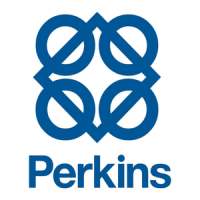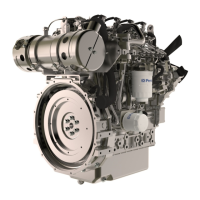
Do you have a question about the Perkins 404C-22T and is the answer not in the manual?
| Engine Model | 404C-22T |
|---|---|
| Displacement | 2.2 liters (134.2 cubic inches) |
| Aspiration | Turbocharged |
| Fuel System | Direct Injection |
| Fuel Type | Diesel |
| Cooling System | Liquid-cooled |
| Torque | 220 Nm |
| Bore | 84 mm (3.3 in) |
| Stroke | 100 mm (3.9 in) |
This section lists basic safety precautions and identifies hazardous situations.
This section guides operators through procedures for inspecting, starting, operating, and stopping.
This section provides step-by-step instructions for engine care based on service hours or calendar time.
Describes warning labels found on the engine and their meanings.
Provides information on general hazards such as pressure air, water, and fluid penetration.
Covers hazards related to hot components, coolant, and potential burns.
Details precautions to prevent fires and explosions from fuels, lubricants, and batteries.
Addresses hazards related to crushing, cutting, and rotating parts.
Outlines essential checks and preparations before starting the engine.
Provides instructions and warnings for safely starting the engine.
Details the correct procedures for stopping the engine safely.
Covers safety aspects of the engine's electrical system, including grounding.
Illustrations showing typical features of the 400 series engines.
Details the mechanical components and arrangement of the 400 series engines.
Explains how Perkins engines are identified by serial numbers and their components.
Information needed to order parts, to be recorded for future reference.
Details the serial number plate location and typical information found on it.
Shows an example of the emissions certification information label.
Provides guidelines for safely lifting and storing the engine.
Details precautions for storing the engine for extended periods to prevent corrosion.
Provides guidelines for maintaining the cooling system to prevent excessive engine wear.
Explains the function and location of the fuel shutoff solenoid.
Outlines essential maintenance and inspections before starting the engine.
Provides instructions and warnings for safely starting the engine.
Instructions for starting the engine using external battery power.
Tips for efficient fuel usage and engine performance.
Details the correct procedure for stopping the engine to prevent damage.
Explains the use of emergency stop controls for critical situations.
Factors affecting engine performance in cold weather, including fuel and oil.
Specific advice for minimizing starting and operating problems in cold temperatures.
Explains the function of the water temperature regulator and insulated lines for cold weather.
Methods for retaining heat in the engine compartment for cold weather.
Discusses fuel properties and their impact on cold weather engine operation.
Information on fuel tank maintenance for water and sediment in cold weather.
Importance of fuel filter micron rating and priming for cold weather.
Details the use and maintenance of fuel heaters for cold weather operation.
Specifies the capacities for engine oil and coolant for various engine models.
Details refill capacities for the engine crankcase oil sump and total lubrication system.
Provides cooling system capacities for engine only and external systems.
Emphasizes following lubricant recommendations for emission certification.
Discusses EMA DHD-1 guidelines as an alternative to API oil classifications.
Explains American Petroleum Institute (API) oil classifications recognized by Perkins.
Covers API classifications and performance of commercial diesel engine oils.
Explains the relationship between TBN, fuel sulfur levels, and oil change intervals.
Recommends specific oils for cold-weather operation based on ambient temperature.
Discusses the use of synthetic base oils and their performance benefits.
Explains the acceptability of re-refined base stock oils meeting specific criteria.
Perkins does not recommend aftermarket oil additives; explains why.
Describes the S-O-S oil analysis as a diagnostic tool for oil performance and wear.
Details the recommended fuel quality specifications for Perkins engines.
Basic information on coolant, including warnings and cleaning reasons.
Specifies acceptable water types and requirements for engine cooling systems.
Explains the role of glycol in coolant and recommended mixtures for freeze/boil protection.
Discusses preferred coolants like Perkins ELC and commercial heavy-duty options.
Correct additions and maintenance for Extended Life Coolant (ELC).
Steps for changing from a heavy-duty coolant to Perkins ELC.
Procedure for cleaning the cooling system when using ELC.
How to add Supplemental Coolant Additive (SCA) to heavy-duty coolant initially.
Procedure for adding SCA to heavy-duty coolant for maintenance.
Steps for cleaning the cooling system of heavy-duty antifreeze.
Maintenance tasks to be performed as needed, not on a fixed interval.
Daily maintenance checks to ensure proper engine operation.
Routine maintenance tasks performed weekly or every 50 service hours.
Maintenance tasks performed every 250 hours or every 6 months.
Maintenance tasks performed every 500 service hours.
Maintenance tasks performed every 500 hours or annually.
Maintenance tasks performed every 1000 service hours.
Maintenance tasks performed every 2000 service hours.
Maintenance tasks performed every 3000 service hours.
Maintenance tasks performed every 3000 hours or every 2 years.
Maintenance tasks performed every 6000 hours or every 3 years.
Procedure for inspecting and adjusting alternator and fan belts for proper tension.
Instructions for replacing worn or damaged alternator and fan belts.
Procedure for checking the battery electrolyte level and condition.
Steps for safely disconnecting battery cables and terminals.
Procedure for replacing the engine air cleaner element.
Instructions for draining the engine oil from the crankcase.
Procedure for removing and replacing the engine oil filter.
Procedure for refilling the engine crankcase with the correct amount of oil.
Provides information regarding engine emissions certification and warranties.











